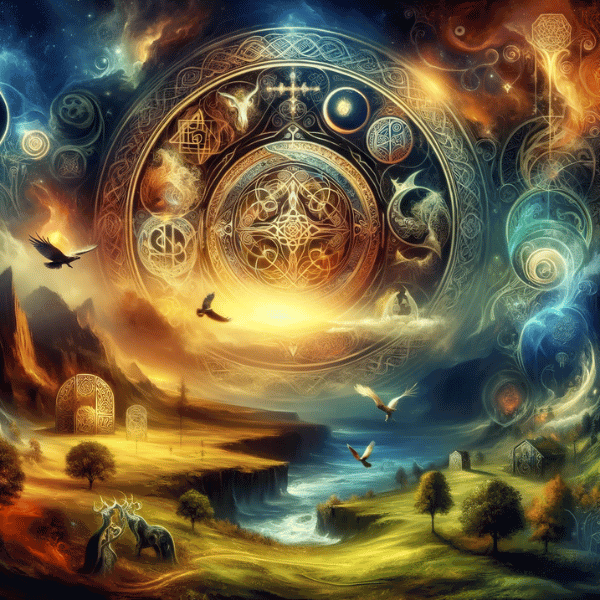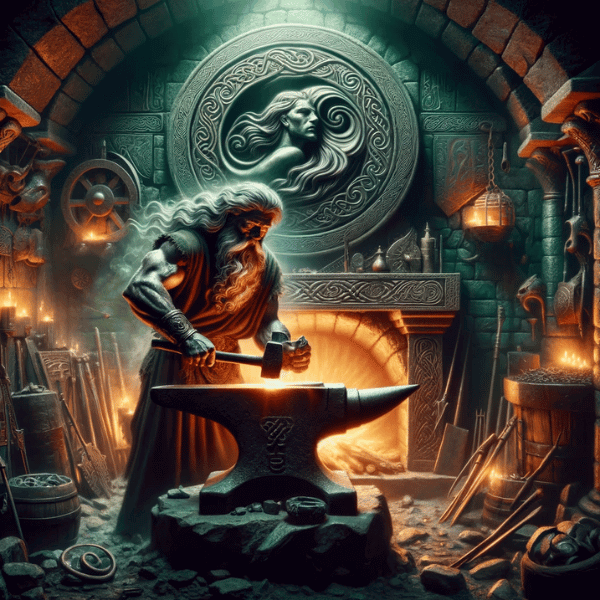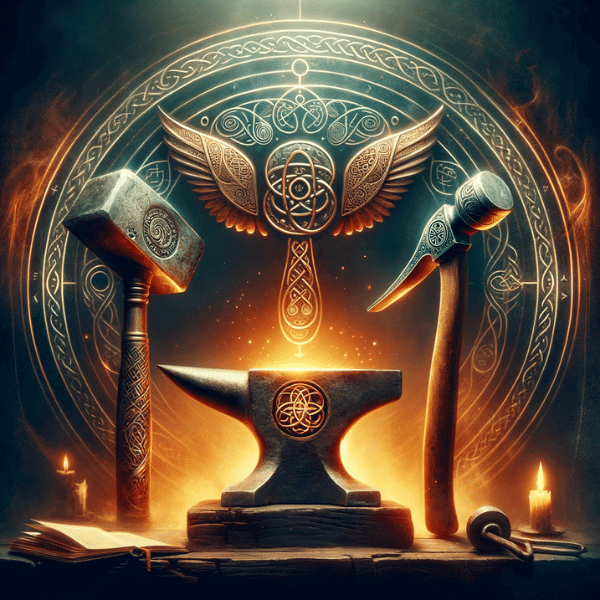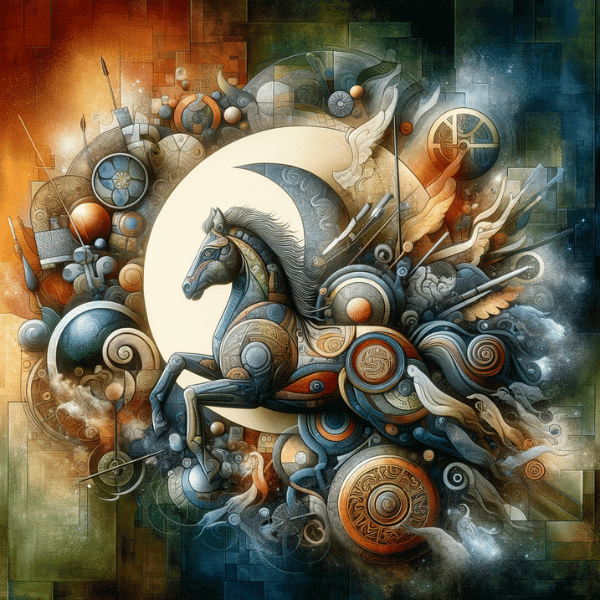Celtic mythology, a tapestry woven with vibrant tales and enigmatic characters, stands as a testament to the rich cultural and spiritual heritage of the Celtic people. Among its pantheon of gods and heroes, Goibniu emerges as a pivotal figure, renowned for his mastery in craftsmanship and blacksmithing. Revered as the divine smith of the Tuatha Dé Danann, Goibniu’s lore encapsulates the ancient Celts’ reverence for creation and the art of forging. His tales, imbued with magic and skill, not only underline the significance of craft in Celtic society but also offer a window into the mystical world where deities directly influenced the material realm. This article delves into the heart of these legends, unraveling the mystique of Goibniu, the god whose hammer and anvil echoed the unparalleled artisanship of the Celtic world.
| Attribute | Goibniu Information |
|---|---|
| Origin | Irish Mythology |
| Deity Type | God of Smithing, Craftsmanship, and the Forge |
| Role | God associated with blacksmithing, craftsmanship, and brewing |
| Magical Skills | Known for his exceptional skills as a blacksmith, crafting weapons and tools |
| Brewer of Ale | Revered as a brewer who produced the ale of immortality |
| Cultural Impact | A significant figure in Irish mythology, symbolizing craftsmanship and skill |
| Depictions | Featured in Irish folklore and myths, often as a master blacksmith and brewer |
1. The Legend of Goibniu
Goibniu’s Mythical Origins and Tales
Goibniu’s stories, deeply rooted in Celtic mythos, begin with his association with the Tuatha Dé Danann, the tribe of the gods. He is often depicted as a figure of immense skill and strength, whose abilities as a blacksmith and craftsman are unparalleled. In the mystical narratives, Goibniu is not just a creator of weapons but also a pivotal character in the defense and triumphs of his people.
Role in the Tuatha Dé Danann
As a member of the Tuatha Dé Danann, Goibniu’s contributions are legendary. Goibniu played a significant role in crafting unbreakable and always lethal weapons, forging swords that never missed their mark and ensuring warriors wielding them never fell in battle. This remarkable skill proved vital in the mythical battles fought by the Tuatha Dé Danann, especially during the legendary Battles of Magh Tuireadh.

Goibniu in the Battles of Magh Tuireadh
In these epic battles, Goibniu’s prowess was not limited to weapon forging. He also participated as a warrior and a strategist. Legends narrate how his weapons ensured the victory of the Tuatha Dé Danann against their formidable foes, the Fomorians. Additionally, Goibniu, along with his brothers Credne and Luchta, formed a triad of craftsmen whose skills were vital in both peacetime and war.
Symbolism and Legacy in Celtic Lore
The tales of Goibniu transcend mere stories; they symbolize the crucial role of craftsmanship and skill in ancient Celtic society. Goibniu’s character represents a bridge between the mortal and the divine, highlighting the belief that skill and artistry were gifts from the gods. His legends continue to be a source of inspiration, reflecting the values of creativity, resilience, and excellence that were revered in Celtic culture.
2. Goibniu’s Role in Celtic Mythology
The Symbolic Essence of Goibniu in Celtic Beliefs
Goibniu’s role in Celtic mythology extends beyond his legendary tales, symbolizing deep cultural and spiritual ideals. He is often perceived as the embodiment of creation and innovation. As the divine blacksmith, his craftsmanship is not merely a profession but a sacred act, representing the transformation of raw materials into meaningful objects. This aligns with the Celtic respect for the harmony between nature and human ingenuity.
Goibniu’s Craftsmanship
In Celtic society, the act of forging was seen as a metaphor for creation and transformation, making Goibniu’s role crucial. His ability to produce flawless weapons and tools signifies the divine intervention in human endeavors, suggesting that the Celts viewed the mastery of any craft as a blend of earthly skill and heavenly guidance.

Comparative Analysis with Other Mythological Figures
Goibniu’s archetype finds echoes in various other mythologies. In Greek mythology, Hephaestus, the god of blacksmiths, shares similarities with Goibniu in terms of craftsmanship and divine attributes. Norse mythology presents Völundr (or Wayland) the Smith, a figure renowned for his extraordinary skills in metalworking. These parallels not only illustrate the universal reverence for craftsmen in ancient cultures but also highlight how different civilizations perceived the act of creation as a divine or magical process.
Goibniu’s Unique Place Amongst Mythological Craftsmen
While there are similarities, Goibniu’s portrayal in Celtic mythology is distinct. He actively intertwines his craftsmanship with the fate of the Tuatha Dé Danann, portraying a formidable figure symbolizing strength and resilience, in contrast to Hephaestus, often depicted with physical imperfections. This distinction underscores the Celtic admiration for physical prowess alongside skill and intellect.
3. Symbolism and Interpretation
Unveiling the Symbols: Forge, Anvil, and Hammer
The symbolism associated with Goibniu is deeply entwined with his tools of trade – the forge, anvil, and hammer. These items are not mere instruments but potent symbols in Celtic mythology. The forge represents transformation and creation, a place where raw materials are reshaped into new forms. The anvil stands as a symbol of endurance and resilience, reflecting the unyielding strength of the Celtic spirit. The hammer, Goibniu’s primary tool, symbolizes the power of creation and destruction, a tangible representation of the god’s might and skill.

Reflection of Celtic Views on Creation and Craftsmanship
These symbols collectively paint a vivid picture of the ancient Celts’ views on creation and craftsmanship. To them, the process of forging was akin to a sacred act, a fine blend of physical effort and mystical influence. The Celts revered the transformation process in the forge, where they saw a point of convergence between the earthly and the divine, turning raw elements into purposeful and beautiful objects, symbolizing their appreciation for balance and harmony in the natural world.
Goibniu’s Tools as Extensions of the Divine
In the hands of Goibniu, these tools transcended their physical utility. They became extensions of his divine power, enabling him to imbue his creations with magical properties. This view reflects the Celtic belief in the interconnectedness of the physical and spiritual realms, where gods directly influenced and participated in the affairs of the world. The perfection of Goibniu’s craftsmanship was not just a testament to his skill but also an indication of divine favor and presence.
The Hammer’s Dual Nature: Creation and Destruction
The hammer, particularly, holds a dual symbolism. On one hand, it is the instrument of creation, shaping and crafting the metal into weapons and tools. On the other hand, it represents the potential for destruction, much like the weapons it forges. This duality is reflective of the Celtic understanding of the natural world, where creation and destruction are seen as two sides of the same coin, both essential to the cycle of life and death.
4. Goibniu’s Legacy in Modern Times
Enduring Influence in Contemporary Culture
The mythology of Goibniu, rich in symbolism and depth, continues to echo in modern times, influencing various facets of contemporary culture. His legacy, rooted in the ancient past, finds expression in modern literature, art, and even in the practices of craftsmanship and creativity.
Goibniu in Literature and Popular Media
In literature, Goibniu’s character has been a source of inspiration for various authors, especially in the fantasy genre. Writers and creators reimagined Goibniu as a master craftsman and a formidable deity, weaving together the mystical and the mundane in novels and stories. In popular media, films, television series, and graphic novels often adapt elements of Goibniu’s myths, portraying him as a symbol of wisdom, strength, and skill.

Artistic Representations and Symbolic Echoes
Artists have also found inspiration in Goibniu’s imagery. From sculptures and paintings to modern digital art, the representation of Goibniu often embodies themes of creation, transformation, and the forge’s primal power. These artistic interpretations serve as a testament to the lasting impact of Celtic mythology on creative expression.
Goibniu’s Influence in Modern Craftsmanship
In the realm of craftsmanship and artisanal practices, Goibniu’s influence is subtly present. Many modern craftsmen and artisans view their work as a continuation of the ancient traditions of creation and skill, often invoking the spirit of Goibniu in their dedication to excellence and innovation. His legacy is celebrated in various cultural festivals and events that honor traditional craftsmanship and the art of blacksmithing.
5. Conclusion
In the tapestry of Celtic mythology, Goibniu stands out as a symbol of craftsmanship, strength, and divine influence. His role as the master blacksmith of the Tuatha Dé Danann encapsulates the ancient Celts’ deep reverence for creation and skill, blending the earthly with the divine. Through his legends, we see a reflection of the cultural and spiritual values that shaped Celtic society, emphasizing the sacredness of craft and the harmonious interplay between nature and human ingenuity. Goibniu’s enduring legacy, permeating modern culture, art, literature, and craftsmanship, attests to the timeless appeal of these ancient myths. His story continues to inspire and resonate, bridging the past with the present, and reminding us of the profound impact of mythology on human civilization and our understanding of the world.
